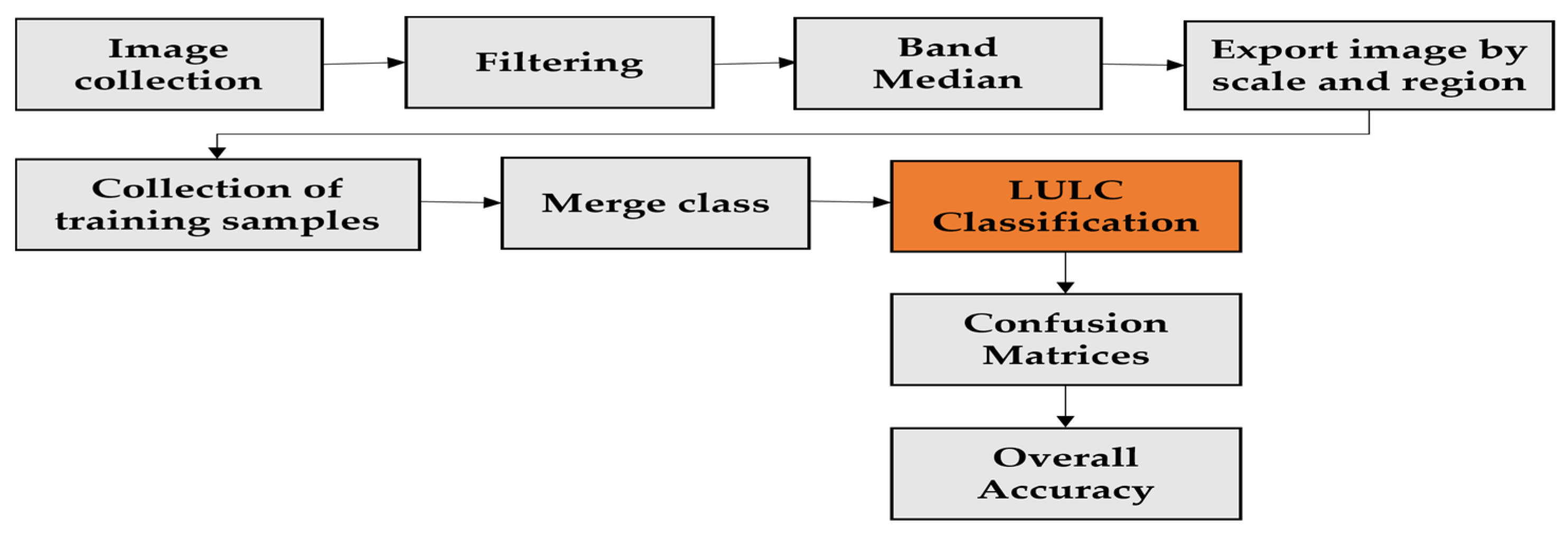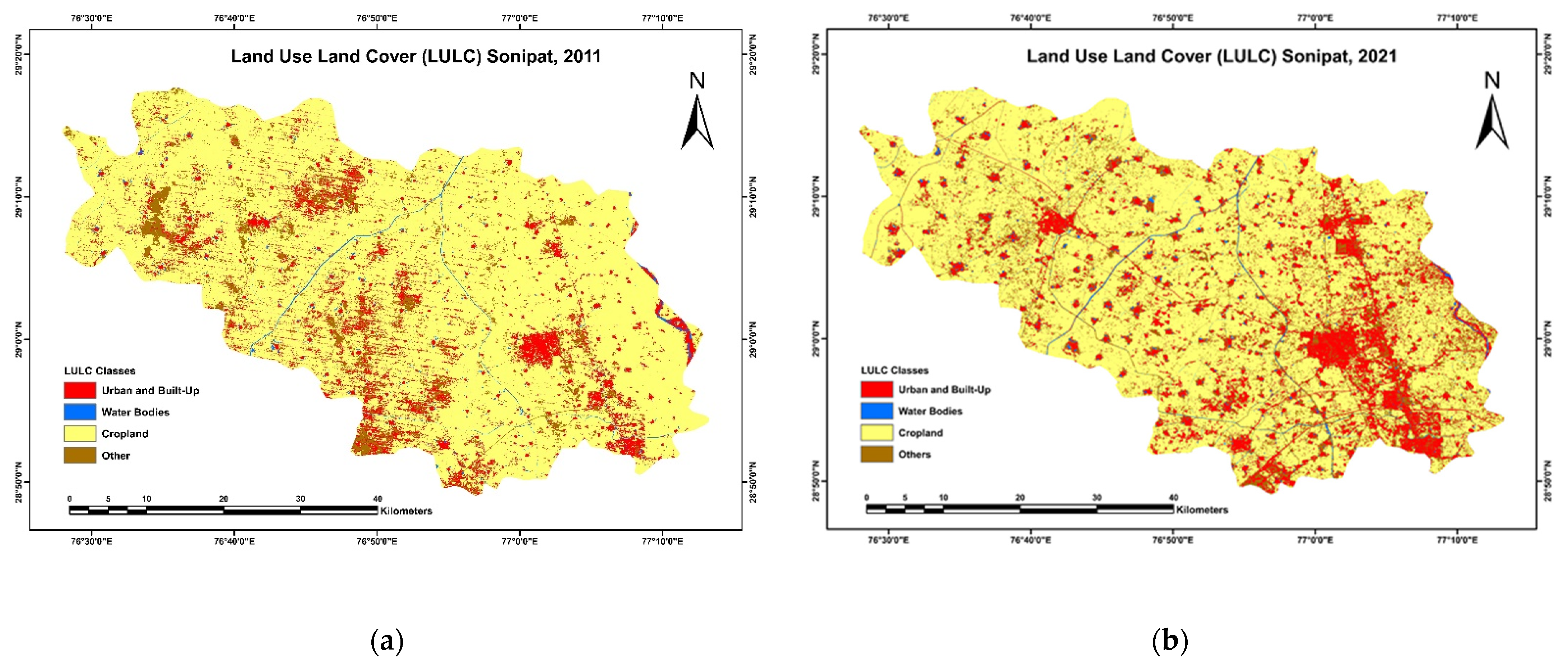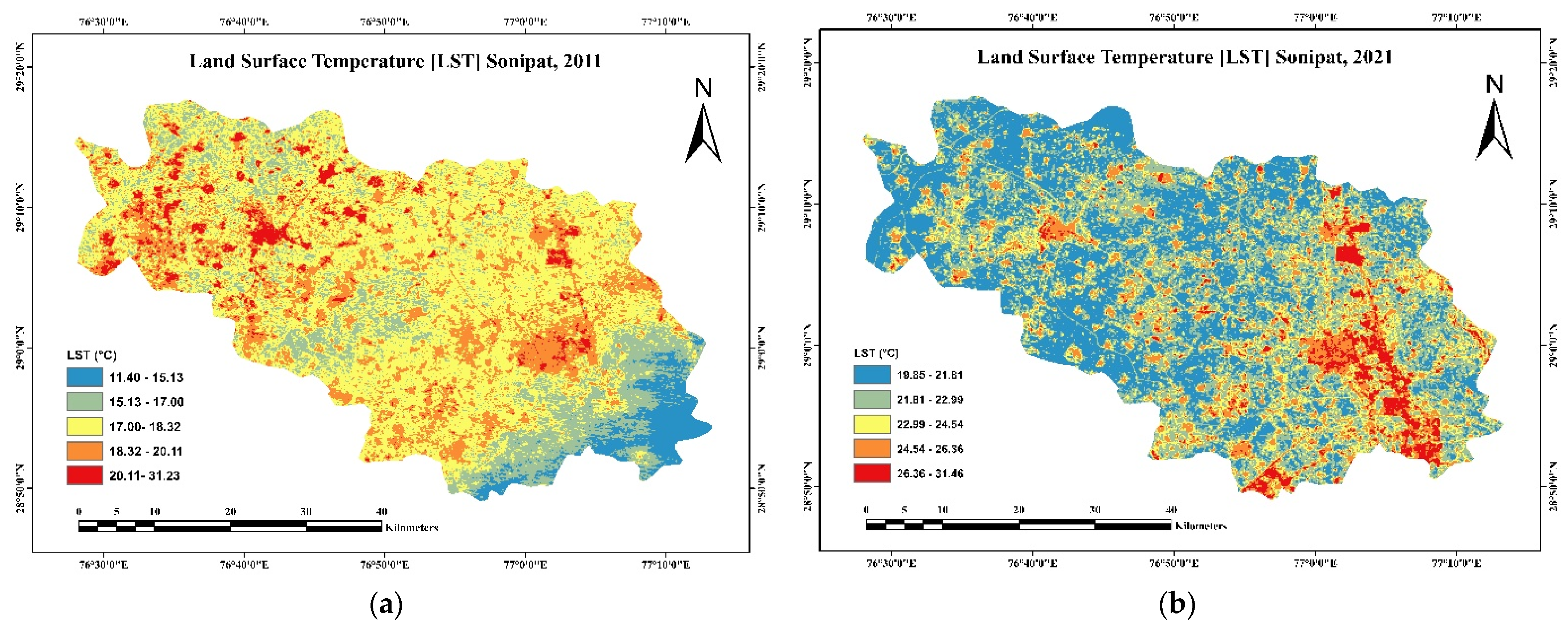Quantitative Estimation of Land Surface Temperature and Its Relationship with Land Use/Cover around Sonipat District, Haryana, India †
Abstract
:1. Introduction
2. Study Area
3. Methodology
3.1. Object-Based LULC Classification in Google Earth Engine (GEE)
3.2. Estimation of LST
3.3. NDVI Calculations
4. Result and Discussion
4.1. LULC Classification
4.2. The Relationship between LST and NDVI by Land Use/Cover Types
5. Conclusions
Institutional Review Board Statement
Informed Consent Statement
Conflicts of Interest
References
- Abd El-Hamid, H.T.; Caiyong, W.; Hafiz, M.A.; Mustafa, E.K. Effects of land use/land cover and climatic change on the ecosystem of North Ningxia, China. Arab. J. Geosci. 2020, 13, 1099. [Google Scholar] [CrossRef]
- Pal, S.; Ziaul, S. Detection of land use and land cover change and land surface temperature in English Bazar urban centre. Egypt. J. Remote Sens. Space Sci. 2017, 20, 125–145. [Google Scholar] [CrossRef] [Green Version]
- Imran, H.M.; Hossain, A.; Islam, A.K.M.; Rahman, A.; Bhuiyan, M.A.E.; Paul, S.; Alam, A. Impact of Land Cover Changes on Land Surface Temperature and Human Thermal Comfort in Dhaka City of Bangladesh. Earth Syst. Environ. 2021, 5, 667–693. [Google Scholar] [CrossRef]
- Das, S.; Angadi, D.P. Land use-land cover (LULC) transformation and its relation with land surface temperature changes: A case study of Barrackpore Subdivision, West Bengal, India. Remote Sens. Appl. Soc. Environ. 2020, 19, 100322. [Google Scholar] [CrossRef]
- Gogoi, P.P.; Vinoj, V.; Swain, D.; Roberts, G.; Dash, J.; Tripathy, S. Land use and land cover change effect on surface temperature over Eastern India. Sci. Rep. 2019, 9, 8859. [Google Scholar] [CrossRef] [PubMed] [Green Version]
- Quantitative estimation of Land Surface Temperature and Its Relationship with Land Use/Cover around Mahan Essar Thermal Power Plant in Singrauli District, Madhya Pradesh, India. Available online: https://www.researchgate.net/publication/321492270_Quantitative_estimation_of_Land_Surface_Temperature_and_its_relationship_with_Land_UseCover_around_Mahan_Essar_Thermal_Power_Plant_in_Singrauli_District_Madhya_Pradesh_India (accessed on 25 September 2021).
- Aboelnour, M.; Engel, B.A.; Aboelnour, M.; Engel, B.A. Application of Remote Sensing Techniques and Geographic Information Systems to Analyze Land Surface Temperature in Response to Land Use/Land Cover Change in Greater Cairo Region, Egypt. J. Geogr. Inf. Syst. 2018, 10, 57–88. [Google Scholar] [CrossRef] [Green Version]
- Nguyen, H.T.T.; Doan, T.M.; Tomppo, E.; McRoberts, R.E. Land Use/Land Cover Mapping Using Multitemporal Sentinel-2 Imagery and Four Classification Methods—A Case Study from Dak Nong, Vietnam. Remote Sens. 2020, 12, 1367. [Google Scholar] [CrossRef]




| Year | Land Use | n | R | R2 | Significance Level |
|---|---|---|---|---|---|
| 2011 | Urban and Built-Up | 20 | −0.341 | R² = 0.1166 | 0.01 |
| Water Bodies | 15 | 0.159 | R² = 0.0255 | 0.01 | |
| Cropland | 30 | −0.759 | R² = 0.5761 | 0.01 | |
| Others Fallow/Barren | 12 | −0.846 | R² = 0.7158 | 0.01 | |
| 2021 | Urban and Built-Up | 20 | −0.490 | R² = 0.2404 | 0.01 |
| Water Bodies | 15 | 0.537 | R² = 0.2884 | 0.01 | |
| Cropland | 30 | −0.598 | R² = 0.3585 | 0.01 | |
| Others Fallow/Barren | 15 | −0.752 | R² = 0.5655 | 0.01 |
Publisher’s Note: MDPI stays neutral with regard to jurisdictional claims in published maps and institutional affiliations. |
© 2021 by the authors. Licensee MDPI, Basel, Switzerland. This article is an open access article distributed under the terms and conditions of the Creative Commons Attribution (CC BY) license (https://creativecommons.org/licenses/by/4.0/).
Share and Cite
Rana, D.; Kumari, M.; Kumari, R. Quantitative Estimation of Land Surface Temperature and Its Relationship with Land Use/Cover around Sonipat District, Haryana, India. Eng. Proc. 2021, 8, 31. https://doi.org/10.3390/engproc2021008031
Rana D, Kumari M, Kumari R. Quantitative Estimation of Land Surface Temperature and Its Relationship with Land Use/Cover around Sonipat District, Haryana, India. Engineering Proceedings. 2021; 8(1):31. https://doi.org/10.3390/engproc2021008031
Chicago/Turabian StyleRana, Diksha, Maya Kumari, and Rina Kumari. 2021. "Quantitative Estimation of Land Surface Temperature and Its Relationship with Land Use/Cover around Sonipat District, Haryana, India" Engineering Proceedings 8, no. 1: 31. https://doi.org/10.3390/engproc2021008031
APA StyleRana, D., Kumari, M., & Kumari, R. (2021). Quantitative Estimation of Land Surface Temperature and Its Relationship with Land Use/Cover around Sonipat District, Haryana, India. Engineering Proceedings, 8(1), 31. https://doi.org/10.3390/engproc2021008031






